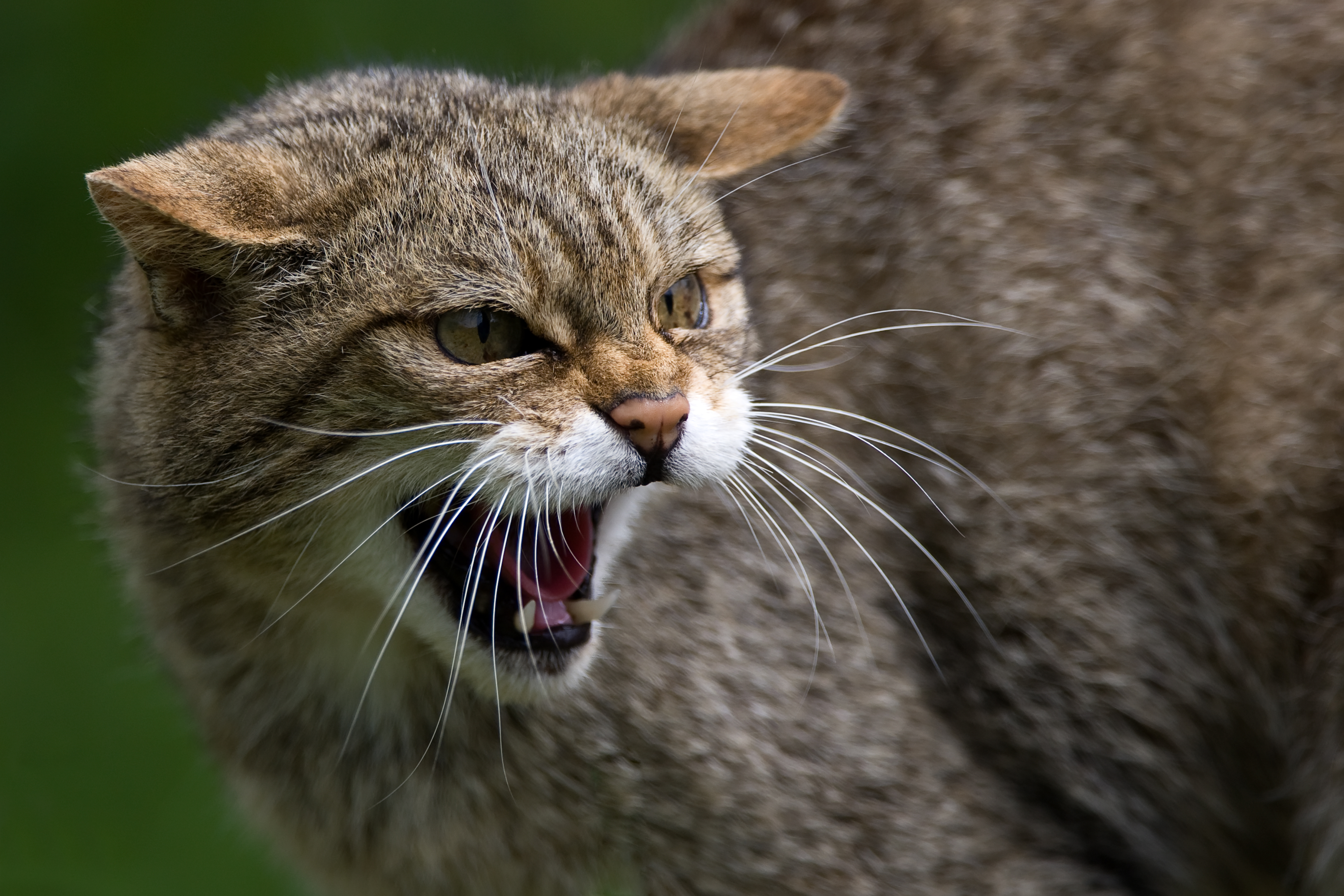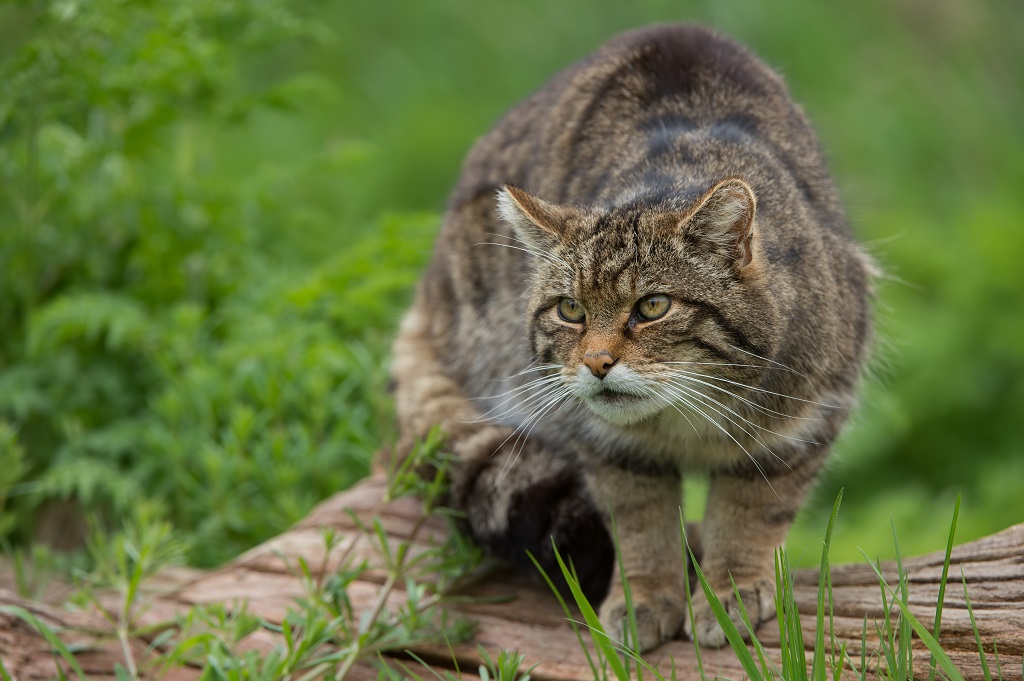With wildcat numbers dwindling, is there hope for Scotland’s feisty feline?
It was only as recently at 1988 that wildcats received the full protection of the law. Before that they were snared, trapped, shot, stuffed and poisoned (a wildcat sporran lurks in our cupboard, a relic from a Victorian relative), and it took a long time before we recognised their true value as one of our most precious wildlife assets. Too many still come to grief.
In 1863, that infamous murderer of Scottish wildlife, Charles St John, wrote, ‘In the hanging birch-woods that border some of the Highland streams, the wildcat is still not uncommon, and I have heard their unearthly cry echo far in the quiet night as they answer and call to each other. I do not know a more harsh and unpleasant cry, or one more likely to be the origin of superstitious fears in the mind of an ignorant Highlander.’
He went on to describe their ‘strength and ferocity’, followed by gory descriptions of how he killed them. Other writers, such as Archibald Thorburn, claimed that the wildcat was untameable, while Pennant claimed in 1776 that it caused havoc among poultry and lambs. They were simply not popular.
Today the wildcat is still under pressure. Just how many true wildcats remain is unknown; estimates fl uctuate from 400 to as low as 40. The spread of un-neutered domestic cats has complicated the situation – many wildcats turn out to be hybrids. In most cases recognition, especially after a fleeting glimpse, is far from easy.

Dr Andrew Kitchener of the National Museums of Scotland has studied the subject intensely; following the examination of some 130 skins collected over a century, he was able to analyse various marking characteristics that make a wildcat different to a hybrid.
There can be little doubt that wildcat numbers have fallen as a result of persecution and our continual infringement of wild places. Tragically, that trend shows no sign of abating.
Developers claim that wildlife will simply move elsewhere if we take over their habitat – but where? Being the shyest of all our mammals wildcats, unlike badgers, red squirrels and pine martens, are less able to adapt. They will struggle to fi nd prey, come into conflict with game interests or be killed on increasingly busy roads.
And it follows that with further housing and leisure developments in prime wildcat habitat, the chances of liaisons between wild and domestic cats will soar. Surely there should be some by-law ensuring that people moving into wildcat strongholds, particularly in areas such as the Cairngorms National Park, have to have their cats neutered.
The planting of huge areas with sterile commercial forestry during the 1970s did little for Scottish wildlife. The wildcat suffered greatly as vast tracts of ideal territory were lost. Habitat restoration must be at the heart of any programme to help them. Some experts advocate a policy of trapping and testing wildcats to assess their genes, but this is hugely stressful to animals.
Donald Houston of the Ardnamurchan Estate agrees that handling wildcats always leads to stress – something I can vouch for. Having worked with injured wildlife most of my life, I have seen the shock this causes any nervous creature.
The late Professor Russell Coope, who successfully bred wildcats in captivity for many years, said that even wildcats with some domestic genes reverted back to wildness and that we should not be too concerned about 100% pureness given that it may be the best we have.
His cats (which, incidentally, are most definitely wild) are now at the Aigas Field Centre at Beauly, where Sir John Lister-Kaye and his team are working on a captive breeding programme under the auspices of SNH. Lister-Kaye feels that there should be a government-led push to educate people to value wildcats as a special item on our British fauna list.
Aigas and other environmental education organisations, such as Kindrogan Field Centre and the North Highland College at Thurso, have a vital role to play in educating the public.

‘Personally, I find trapping and micro-chipping a step too far,’ says Lister-Kaye. ‘I accept that radio tracking has helped with conservation of other species, and there may be a good scientific argument for it, but I think scientific interference should be the exception, rather than the rule.’
The Aigas wildcat project will be part of an education programme giving visitors and special-interest groups the opportunity to see what a wildcat actually looks like. Most people will never catch even a glimpse of one. The Aigas project will be small, with three pairs of breeding wildcats hopefully producing four to six kittens a year. These will be released in suitable habitat after 18 months, in collaboration with conservation partners.
Lister-Kaye, a naturalist of the highest calibre, is adamant that any breeding programme must be in conjunction with habitat restoration. Wildcats need undisturbed areas with abundant vole and rabbit populations – a tall order given that wild Scotland seems to be shrinking.
I am fortunate to have had wonderful wildcat sightings and still return to remote areas of the west that I have known since childhood to find signs of wildcats, in the knowledge that with fewer threats here they appear to be thriving.
In the late 1960s and early 1970s wildcats were seen relatively frequently in Ardnamurchan. One, backed into the corner of the henhouse, sent me flying out with great speed, while another with kittens in a den in a dumped Land Rover where we were playing would certainly have left us scarred had we not retreated immediately.
She vanished, taking her kittens with her, and was not seen again. Once disturbed, wildcats seldom come back to the same area – and now, with shrinking habitat, where can they go? Optimistically, I hope that there are more wildcats left than predicted.
Whatever the situation, we have no time to lose, and need to stop talking, trapping and testing, and protect known wildcat haunts from disturbance of any kind. Only then will this symbol of wild Scotland have a chance to build up its numbers once again.
- This feature was originally published in 2013.
TAGS

